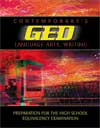 |  Contemporary's GED Language Arts, Writing Ellen Carley Frechette
Tim Collins
Using Verbs
Chapter OutlineStudy the chapter outline below. Use the page numbers below each topic to refer to the corresponding section in Contemporary's GED Language Arts, Writing. When you are finished, go to the Flashcards or choose a different activity or chapter from the menu on the left.
Simple Tenses
(See pages 51 and 52)
The time showed by a verb is called its tense.
-
The simple present tense shows an action or state of being that is happening now or happens regularly.
-
The simple past tense shows an action that occurred at a specified time in the past.
-
The simple future tense shows an action that has not yet taken place but will in the future.
|
 |  |  | Irregular Verbs
(See page 57–59)
Most verbs in the English language follow a regular pattern for forming different tenses, but many important verbs are irregular. | Base Verb | Present Tense | Past Tense | Perfect Tense |
|---|
| be | am, is, are | was, were | (have, has, had) been | | do | do, does | did | (have, has, had) done | | have | has, have | had | (have, has, had) had | | go | go, goes | went | (have, has, had) gone | | see | see, sees | saw | (have, has, had) seen | | bring | bring, brings | brought | (have, has, had) brought |
Several verb pairs are tricky because they sound so much alike but have slightly different meanings.
-
lay and lie
-
set and sit
-
raise and rise
|
 |  |  | Inverted Word Order
(See pages 66 and 67)
- The subject of an inverted sentence has to be determined in order to make it agree with the verb in number.
- It can also be hard to identify the subject in a command or in a sentence that begins with an introductory phrase.
|
 |  |  | Indefinite Pronouns
(See pages 71–73)
An indefinite pronoun is a pronoun that does not name a specific person or thing.
-
The following indefinite pronouns are always singular: anyone, anything, anybody, each, either, neither, no one, nothing, nobody, everyone, everything, everybody, one, someone, something, somebody.
-
The following indefinite pronouns are always plural: both, few, many, several.
-
The following indefinite pronouns can be either singular or plural depending on their antecedent: all, any, some, most, none.
|
|



 2002 McGraw-Hill Higher Education
2002 McGraw-Hill Higher Education